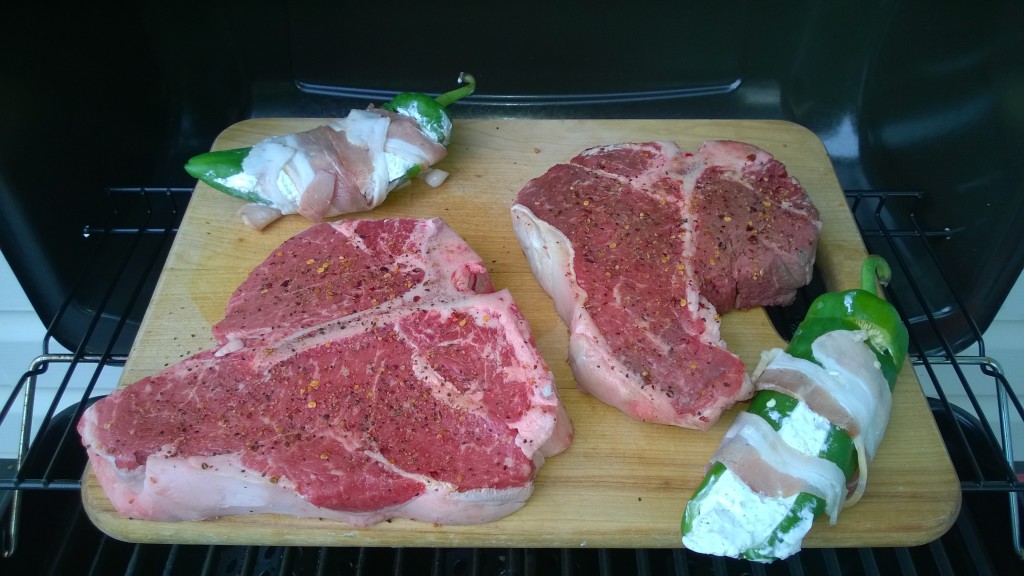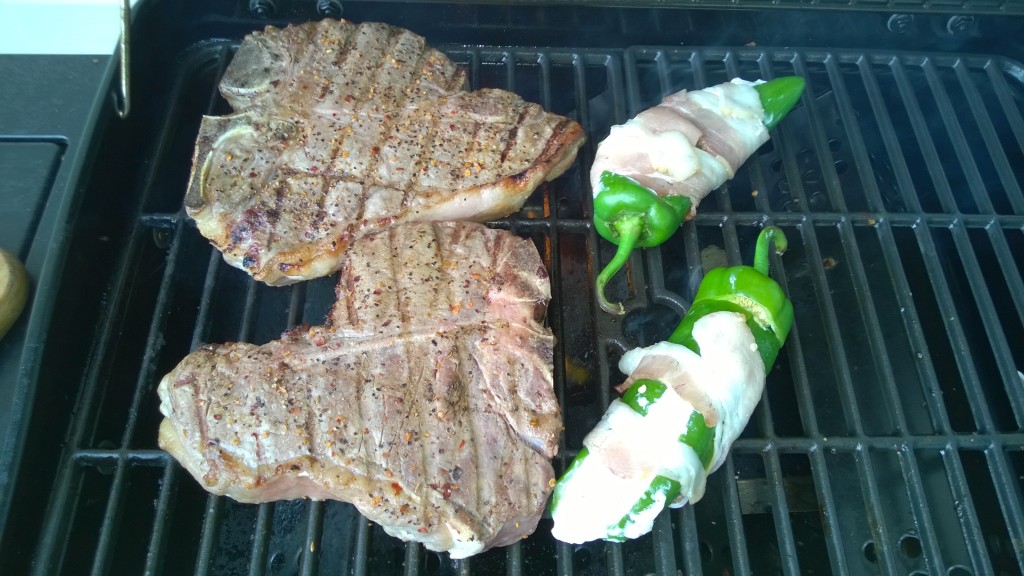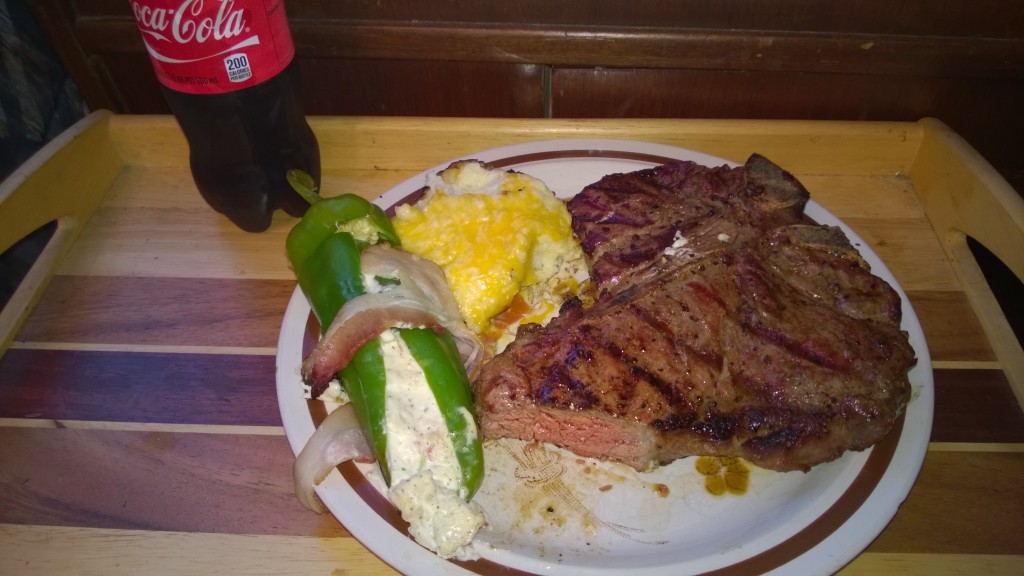Barack Obama is asking Americans to believe that cows (and their diet) are causing global warming and climate change. Here’s his evidence:
According to a paper (2008) written by Virginia A. Ishler of Pennsylvania State University (Penn State) agriculture contributes approximately 6 to 7% of the total U.S. greenhouse gas emissions. Methane from enteric (microbial) fermentation represents 20% and manure management 7% of the total CH4 emitted. Ruminants (beef, dairy, goats, and sheep) are the main contributors to CH4 production.
Approximately 132 to 264 gallons of ruminal gas produced by fermentation are belched each day. The eructation of gases via belching is important in bloat prevention but is also the way CH4 is emitted into the atmosphere.
Then there is the EPA (US Environmental Protection Agency) report, Inventory of US Greenhouse Gas Emissions and Sinks: 1990-2004, which states that beef cattle remain the largest contributor of CH4 emissions, accounting for 71% in 2004. Dairy cattle accounted for 24% and the remaining emissions were from horses, sheep, swine, and goats. Generally, emissions have been decreasing mainly due to decreasing populations of both beef and dairy cattle and improved feed quality for feedlot cattle.
Virginia A. Ishler says that we can fix the problem with cow diets:
Dietary strategies to lower methane emissions
Some dietary practices that have been shown to reduce CH4 include the addition of ionophores, fats, the use of high quality forages, and the increased use of grains. These nutritional strategies reduce CH4through the manipulation of ruminal fermentation, direct inhibition of the methanogens and protozoa, or by a redirection of hydrogen ions away from the methanogens.
Relatively new mitigation options have been investigated and include the addition of such additives as probiotics, acetogens, bacteriocins, organic acids, and plant extracts (i.e. condensed tannins). For the long term approach, genetic selection of cows that have improved feed efficiency is a possibility. The following gives more detail about some of the strategies that reduce CH4:
A. Increasing the efficiency in which animals use nutrients to produce milk or meat can result in reduced CH4 emissions. This can be accomplished by feeding high quality, highly digestible forages or grains. However, the emissions produced in producing and/or transporting the grain or forage should be considered.
B. Rumen modifiers such as ionophores improve dry matter intake efficiency and suppress acetate production, which results in reducing the amount of hydrogen released. In some of the published research, CH4 has been reduced by 10%, however the effect of the ionophores have been short-lived in respect to CH4 reduction. More research on the continued use of ionophores for this purpose is needed.
C. The grinding and pelleting of forages can reduce emissions by 40%, however the costs associated with this practice may be prohibitive.
D. Dietary fats have the potential to reduce CH4 up to 37%. This occurs through biohydration of unsaturated fatty acids, enhanced propionic acid production, and protozoal inhibition. The effects are variable and lipid toxicity to the rumen microbes can be a problem. This strategy can affect milk components negatively and result in reduced income for the producer.
I myself am a proponent of cow diets and the cow diet that I advocate is provided in the following picto-recipe (copyright protected by Lucas Daniel Smith):
A.
Lucas Daniel Smith © 2014
B.
Lucas Daniel Smith © 2014
C.
Lucas Daniel Smith © 2014
Please exercise your free speech in the comments section below. There are no stipulations of political correctness on this blog. Speak your mind, give us your thoughts, both objective and subjective. Share your ideas, hunches, inklings or your expertise. Please provide recommendation and corrections if you spot errors in fact within the blog report. Lastly, remember that posting a comment is much like casting a vote, so please do so.












Carbon, Methane Emissions and the Dairy Cow
Written by Virginia Ishler, Penn State
Reviewed by Gabriella Varga and Robert Graves, Penn State
DAS 08-127; published May 2008
http://extension.psu.edu/animals/dairy/nutrition/nutrition-and-feeding/diet-formulation-and-evaluation/carbon-methane-emissions-and-the-dairy-cow-1
— All very interesting Lucas — but EVERYBODY (LOL) wants to know about the significance of ‘COW FLATULENCE’ to the problem!
————————————————–
Do Cow Farts Actually Contribute to Global Warming?
GIZMODO
Matt Blitz
4/11/2014
Excerpt:
There are currently approximately 1.3 to 1.5 billion cows grazing, sleeping, and chewing their cud at any given time on planet Earth. And these 1,300 pound (average weight for both a beef and dairy cow) animals eat a lot. Much like humans, when they eat, gas builds up inside of their guts and has to be expelled. (See Why Beans Make You Fart) Cows fart and burp… a lot. The result is a large amount of methane being introduced into the atmosphere.
In a 2006 United Nations’ Food and Agricultural Organization report, it claims that the livestock sector, most of which are cows, “generates more greenhouse gas emissions as measured in CO2 equivalent – 18 percent – than transport.” According to a Danish study, the average cow produces enough methane per year to do the same greenhouse damage as four tons of carbon dioxide. So is this significantly contributing to global warming?
Let’s start with how and why cows produce so much methane gas. Cows, sheep, goats, giraffes, and deer belong to a class of mammals called ruminants. Most ruminants have four stomachs, two-toed feet, and store their food in the first chamber of the stomach, called the rumen, before regurgitating it. This regurgitated food is called “cud” and the animals chew it again to help further break it down to make it easier to digest. Inside of the rumen, over four hundred different kinds of microbes exist that also play a critical role in the digestion process. Several of these microbes create methane gas as a byproduct. Due to the sheer number of cows on the planet, along with the large size per cow, our tasty friends produce more methane gas than all other ruminants combined.
Why could this potentially be bad? Methane is twenty one times more potent at trapping heat from the Sun than carbon dioxide. Though it is less prevalent in the atmosphere than carbon dioxide, it is, by unit, the most destructive of the greenhouse gases. Since the turn of the 19th century, methane gas emissions have increased by 150%, according to NASA’s Goddard Institute.
Methane gas, like all other greenhouse gases (which includes water vapor), acts like a blanket around our planet, trapping heat. The right amount and the planet has an average temperature of a life-supporting 59 degrees Fahrenheit. Too little and the greenhouse effect becomes weak, like on Mars. Too much and the surface of the planet becomes so hot “it can melt lead,” like on Venus.
Livestock is the largest source of methane gas emissions worldwide, contributing over 28 percent of total emissions. Wetlands, leaks from oil refineries and drills, and landfills also contribute methane gas to the atmosphere. In fact, unlike the ratios on a global scale, in the United States livestock is only the third largest contributor, behind the mining and transportation of natural gas and rotting landfill waste.
In actuality it’s not as much the farting that’s the problem, cows’ burping and manure contribute more methane gas than flatulence. According to researchers at New Zealand’s largest Crown Research Institute, AGResearch, up to 95 percent of the emissions comes from the cow’s mouth rather than its behind. It’s estimated, through whichever orifice, that each individual cow lets out between thirty and fifty gallons of methane per day. With an estimated 1.3 to 1.5 billion cattle in the world today, this adds up fast. – (bold emphasis added)
………………………………..
View the complete article at:
http://gizmodo.com/do-cow-farts-actually-contribute-to-global-warming-1562144730
Why Cow Farts and Belches Are Obama’s Next Big Targets on Climate Change:
Methane from natural gas and agriculture industries is the second-biggest climate threat.
Written by Rebecca Leber, New Republic
Published July 31st 2014
http://www.newrepublic.com/article/118887/methane-next-climate-initiative-obama
I totally support the Lucas Daniel Smith, COW DIET © 2014 which appears to be based nutritionally on a Medium Rare (?) T-bone, cooked to perfection!
After all —
If God didn’t want us to eat cows, he wouldn’t have made them out of delicious MEAT!
Bruce wrote:
Thanks, Bruce!
Bruce wrote:
i think u and lukas r both EVIL for teling peple to eat cows and talking about cow farts
eat mor chikn
ps. i lik this web site and even us cows now know that obahma was born in kenya
Hundreds of Methane Plumes Erupting Along East Coast
LiveScience.com / via Yahoo News
By Becky Oskin, Senior Writer
8/24/2014
In an unexpected discovery, hundreds of gas plumes bubbling up from the seafloor were spotted during a sweeping survey of the U.S. Atlantic Coast.
Even though ocean explorers have yet to test the gas, the bubbles are almost certainly methane, researchers report today (Aug. 24) in the journal Nature Geoscience.
“We don’t know of any explanation that fits as well as methane,” said lead study author Adam Skarke, a geologist at Mississippi State University in Mississippi State.
Surprising seeps
Between North Carolina’s Cape Hatteras and Massachusetts’ Georges Bank, 570 methane seeps cluster in about eight regions, according to sonar and video gathered by the National Oceanographic and Atmospheric Administration ship Okeanos Explorer between 2011 and 2013. The vast majority of the seeps dot the continental slope break, where the seafloor topography swoops down toward the Atlantic Ocean basin. …
The Okeanos Explorer used sound waves to detect the methane bubbles and map the seafloor. The technique, called multibeam sonar, calculates the time and distance it takes for sound waves to travel from the ship to the seafloor and back. The sonar can also detect the density contrast between gas bubbles and seawater.
Huge canyons etched in the shallow continental shelf also hide bubble plumes, as well as diverse ecosystems that are based on methane-loving bacteria. In 2013, researchers explored a handful of these seeps with Jason, a remotely operated vehicle, finding them teeming with crabs, fish and mussel beds. In Norfolk canyon off the coast of Virginia, researchers from the University of North Carolina at Wilmington discovered the largest methane seep ever found in the Atlantic Ocean, and possibly all the world’s oceans. …
Most of the methane seeps are in water less than 1,640 feet (500 meters) deep. Most of these shallow methane seeps seem to arise from microbes blurping out methane, the researchers said. The researchers did find some deeper methane vents, at which the ROV Jason glimpsed patches of methane hydrate. This is the icy mix of methane and water that appears when deep ocean pressures and cold temperatures force methane to solidify. Any type of methane gas can form hydrates.
While methane vents are common around the world, only three natural gas seeps — where methane escapes from seafloor sediments — had been found off the East Coast before 2012.
“It was a surprise to find these features,” Skarke said. “It was unexpected because many of the common things associated with methane gas do not exist on the Atlantic margin.”
Gas, gas, gas?
Hundreds of Methane Plumes Erupting Along East Coa …
An illustration of the Atlantic margin showing the relationship between methane seeps and seafloor f …
The East Coast is a passive margin, and methane isn’t expected to come out of this environment. The margin hasn’t been squeezed or pulled by plate tectonic activity for tens of millions of years, and that means a lack of escape routes for methane. “I usually describe passive margins as cold, old and boring,” said study co-author Carolyn Ruppel, chief of the U.S. Geological Survey gas hydrates project in Woods Hole, Massachusetts. …
…………………………………………
View the complete article, including photos and images, at:
http://news.yahoo.com/hundreds-methane-plumes-erupting-along-east-coast-170504645.html
Bruce wrote:
Bruce,
Do you think that this could be an environmental ‘side effect’ of fracking?
@ Bruce:
>>>>> BRUCE , THERE IS MORE TO THE SUBJECT OF EATING MEAT. <<<<<
THE SCRIPTURE IN LEVITICUS AND DEUTERONOMY STATE : " FOR THE FEAST OF TABERNACLES , TAKE AND EAT WHAT YOU WILL – A LAMB , A YOUNG GOAT OR A YOUNG BULLOCK ". IT ALSO SAYS TO TAKE WINE OR OTHER FERMENTED DRINK . GOD ' S FOOD LAWS ARE VERY SPECIFIC AS TO CLEAN AND UNCLEAN THINGS TO EAT .
AMERICAN ADVOCATE wrote:
i am a young uncastrated iowa bullock – See https://en.wikipedia.org/wiki/Bullock
i dont care what your bible says
it makes me angry that u, bruce and lukas just luv eating beef even if it is delicious and you think God wants u to do that
eat mor chickn and impeach obahma
ps. i stil like a tumble in the hay every now and then with that cute heifer next farm over. i dont want to become some humans medium rare t-bone steak
Lucas Daniel Smith wrote:
I don’t think the scenario you describe is likely due to the great distance (200+ miles?) between where any fracking is possibly being done and the waters off the East Coast where the methane plumes have been found.
It is my understanding that any subsurface effects resulting from fracking would be much more localized to where the fracking is actually occurring.
Image credit: http://www.climatecentral.org/news/fracking-the-usa-maps-show-americas-1.1-million-oil-and-gas-wells-17226
Obama Pursuing Climate Accord in Lieu of Treaty
The New York Times
Coral Davenport
8/26/2014
Excerpt:
WASHINGTON — The Obama administration is working to forge a sweeping international climate change agreement to compel nations to cut their planet-warming fossil fuel emissions, but without ratification from Congress.
In preparation for this agreement, to be signed at a United Nations summit meeting in 2015 in Paris, the negotiators are meeting with diplomats from other countries to broker a deal to commit some of the world’s largest economies to enact laws to reduce their carbon pollution. But under the Constitution, a president may enter into a legally binding treaty only if it is approved by a two-thirds majority of the Senate.
To sidestep that requirement, President Obama’s climate negotiators are devising what they call a “politically binding” deal that would “name and shame” countries into cutting their emissions. The deal is likely to face strong objections from Republicans on Capitol Hill and from poor countries around the world, but negotiators say it may be the only realistic path.
“If you want a deal that includes all the major emitters, including the U.S., you cannot realistically pursue a legally binding treaty at this time,” said Paul Bledsoe, a top climate change official in the Clinton administration who works closely with the Obama White House on international climate change policy.
Lawmakers in both parties on Capitol Hill say there is no chance that the currently gridlocked Senate will ratify a climate change treaty in the near future, especially in a political environment where many Republican lawmakers remain skeptical of the established science of human-caused global warming.
“There’s a strong understanding of the difficulties of the U.S. situation, and a willingness to work with the U.S. to get out of this impasse,” said Laurence Tubiana, the French ambassador for climate change to the United Nations. “There is an implicit understanding that this not require ratification by the Senate.”
American negotiators are instead homing in on a hybrid agreement — a proposal to blend legally binding conditions from an existing 1992 treaty with new voluntary pledges. The mix would create a deal that would update the treaty, and thus, negotiators say, not require a new vote of ratification.
Countries would be legally required to enact domestic climate change policies — but would voluntarily pledge to specific levels of emissions cuts and to channel money to poor countries to help them adapt to climate change. Countries might then be legally obligated to report their progress toward meeting those pledges at meetings held to identify those nations that did not meet their cuts.
“There’s some legal and political magic to this,” said Jake Schmidt, an expert in global climate negotiations with the Natural Resources Defense Council, an advocacy group. “They’re trying to move this as far as possible without having to reach the 67-vote threshold” in the Senate.
The strategy comes as scientists warn that the earth is already experiencing the first signs of human-caused global warming — more severe drought and stronger wildfires, rising sea levels and more devastating storms — and the United Nations heads toward what many say is the body’s last chance to avert more catastrophic results in the coming century.
At the United Nations General Assembly in New York next month, delegates will gather at a sideline meeting on climate change to try to make progress toward the deal next year in Paris. A December meeting is planned in Lima, Peru, to draft the agreement.
In seeking to go around Congress to push his international climate change agenda, Mr. Obama is echoing his domestic climate strategy. In June, he bypassed Congress and used his executive authority to order a far-reaching regulation forcing American coal-fired power plants to curb their carbon emissions. That regulation, which would not be final until next year, already faces legal challenges, including a lawsuit filed on behalf of a dozen states.
……………………………………………….
View the complete article at:
http://www.nytimes.com/2014/08/27/us/politics/obama-pursuing-climate-accord-in-lieu-of-treaty.html?